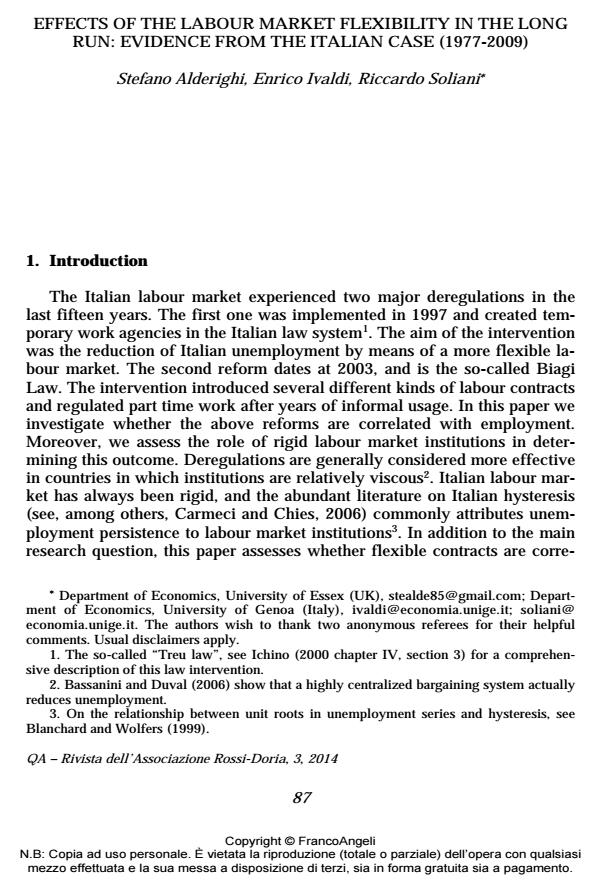Effects of the labour market flexibility in the long run: evidence from the italian case (1977-2009)
Titolo Rivista QA Rivista dell’Associazione Rossi-Doria
Autori/Curatori Stefano Alderighi, Enrico Ivaldi, Riccardo Soliani
Anno di pubblicazione 2014 Fascicolo 2014/3 Lingua Italiano
Numero pagine 24 P. 87-110 Dimensione file 163 KB
DOI 10.3280/QU2014-003004
Il DOI è il codice a barre della proprietà intellettuale: per saperne di più
clicca qui
Qui sotto puoi vedere in anteprima la prima pagina di questo articolo.
Se questo articolo ti interessa, lo puoi acquistare (e scaricare in formato pdf) seguendo le facili indicazioni per acquistare il download credit. Acquista Download Credits per scaricare questo Articolo in formato PDF

FrancoAngeli è membro della Publishers International Linking Association, Inc (PILA)associazione indipendente e non profit per facilitare (attraverso i servizi tecnologici implementati da CrossRef.org) l’accesso degli studiosi ai contenuti digitali nelle pubblicazioni professionali e scientifiche
Effetti della flessibilità del mercato del lavoro nel lungo periodo: riscontro empirico dal caso italiano (1977-2009) Il presente lavoro studia se la deregolamentazione del mercato del lavoro sia correlata con l’aumento dell’occupazione in Italia e la discesa del potere del sindacato. La nostra ipotesi è che tale correlazione non sussista e che i contratti flessibili abbiano assecondato la dicotomia fra industria e terziario, senza esserne causa. Per verificare ciò, applichiamo dapprima l’analisi delle componenti principali, poi la regressione. L’ipotesi è quasi sempre confermata. I contratti flessibili non sono correlati con la creazione di occupazione giovanile, mentre il declino del sindacato è correlato con indicatori macroeconomici diversi dai contratti flessibili. Questi interventi hanno assecondato un processo già in essere, causato da un cambiamento strutturale nel paradigma produttivo.;
Keywords:Mercato del lavoro, Flessibilità del lavoro, Sindacato, Disoccupazione, Italia, 1977-2009
- Bassanini A., Duval R. (2006), «Employment Patterns in OECD Countries: Reassessing the Role of Policies and Institutions», OECD Social, Employment and Migration Working papers, 35, Paris, France.
- Bentolila S., Bertola G. (1990), «Firing Costs and Labor Demand: How Bad is Eurosclerosis? », Review of Economic Studies, 57, 3, pp. 381-402.
- Bentolila S., Saint-Paul G. (1995), «A Model of Labour Demand with Linear Adjustment Costs», Labour Economics, 2, 1, pp. 105-105.
- Berton F., Devicienti F., Pacelli L. (2008), «Temporary Jobs: Port of Entry, Trap or Unobserved Heterogeneity?», Laboratorio Riccardo Revelli Working Papers, 79.
- Bertola G., Blau F.D., Kahn L.M. (2007), «Labour Market Institutions and Demographic Employment Patterns», Journal of Population Economics, 20, pp. 833-867.
- Bertola G., Garibaldi P. (2003), «The Structure and History of Italian Unemployment », CESifo Working Paper Series, 907.
- Blanchard O., Landier A. (2002), «The Perverse Effects of Partial Labour Market Reform: Fixed-Term Contracts in France», Economic Journal, 112, pp. 214-244.
- Blanchard O., Wolfers J. (1999), «The Role of Shocks and Institutions in the Rise of European Unemployment: The Aggregate Evidence», NBER Working Papers, 7282. Booth A. (1995), The Economics of the Trade Union, Cambridge University Press, Cambridge (UK).
- Booth A.L., Francesconi M., Frank J. (2002), «Temporary Jobs: Stepping Stones or Dead Ends?», Economic Journal, 112, pp. 189-213.
- Carmeci G., Chies L. (2006), «Hysteresis in Unemployment: Do Structural Breaks and Aggregation Matter? First Results from Italy», Working Paper Università di Trieste, 106.
- Checchi D. (2012), «Labour Market Reforms and Inequality in Italy» in Magara H., Sacchi S. (eds.), The Politics of Social and Industrial Reforms: In Comparative Analysis of Italy and Japan, Edward Elgar, Cheltenham.
- Dellas H., Sakellaris P. (2003), «On the Cyclicality of Schooling: Theory and Evidence », Oxford Economic Papers, 55, pp. 148-177.
- European Central Bank (2000), Monthly Bulletin, October.
- Maravall A., Del Rio A. (2001), Time Aggregation and the Hodrick-Prescott Filter, Banco de España, Madrid.
- Dillon W., Goldstein M. (1984), Multivariate Analysis Method and Application, Wiley, Hoboken.
- Hodrick R., Prescott E.P. (1997), «Postwar Business Cycles: An Empirical Investigation », Journal of Money, Credit and Banking, 29, pp. 1-16.
- Ichino P. (2000), «Il contratto di lavoro – volume 1», Trattato di diritto civile e commerciale, volume XXVII, t.2, Giuffré, Milano.
- Ichino A., Mealli F., Nannicini T. (2005), «Temporary Work Agencies in Italy: A Springboard Toward Permanent Employment?», Giornale degli economisti e Annali di Economia, 64, pp. 1-27.
- Ichino A., Mealli F., Nannicini T. (2008), «From Temporary Help Jobs to Permanent Employment: What Can We Learn from Matching Estimators and Their Sensitivity?», Journal of Applied Econometrics, 23, pp. 305-327.
- Jimeno J.F., Rodriguez-Palenzuela D. (2002), «Youth Unemployment in the OECD: Demographic Shifts, Labour Market Institutions, and Macroeconomic Shocks», ECB Working paper, 155.
- Maravall A., del Río A. (2007), «Temporal Aggregation, Systematic Sampling, and the Hodrick-Prescott Filter», Computational Statistics& Data Analysis, Elsevier, 52, 2, pp. 975-998, October.
- McDonald I.M., Solow R.M. (1981), «Wage Bargaining and Employment», American Economic Review, 71, pp. 896-908.
- Nickells S.J. (1982), «A Bargaining Model of the Phillips Curve», London School of Economics, Centre for Labour Economics Discussion Paper, 130.
- Nickells S.J., Andrews M. (1983), «Unions, Real Wages and Employment in Britain 1951-79», Oxford Economic Papers, 35, Supplement, pp. 183-206.
- O’Higgins N. (2012), «This Time Its Different? Youth Labour Markets During “The Great Recession”», Comparative Economic Studies, 54, 2, pp. 395-412.
- Oswald A.J. (1993), «Efficient Contracts Are on the Labour Demand Curve. Theory and Facts», Labour Economics, pp. 85-113.
- Ravn O.M., Uhlig H. (2002), «On Adjusting the Hodrick-Prescott Filter for the Frequency of Observations», Review of Economics and Statistics, 84, 2, pp. 371-375.
- Sakellaris P., Spilimbergo A. (2000), «Business Cycles and Investment in Human Capital: International Evidence on Higher Education», Carnegie-Rochester Conference Series on PublicPolicy, Elsevier, 52, 1, pp. 221-256,
- Visser J. (2006), «Union Membership Statistics in 24 Countries», Monthly Labor Review, 129, January, pp. 38-49.
Stefano Alderighi, Enrico Ivaldi, Riccardo Soliani, Effects of the labour market flexibility in the long run: evidence from the italian case (1977-2009) in "QA Rivista dell’Associazione Rossi-Doria" 3/2014, pp 87-110, DOI: 10.3280/QU2014-003004